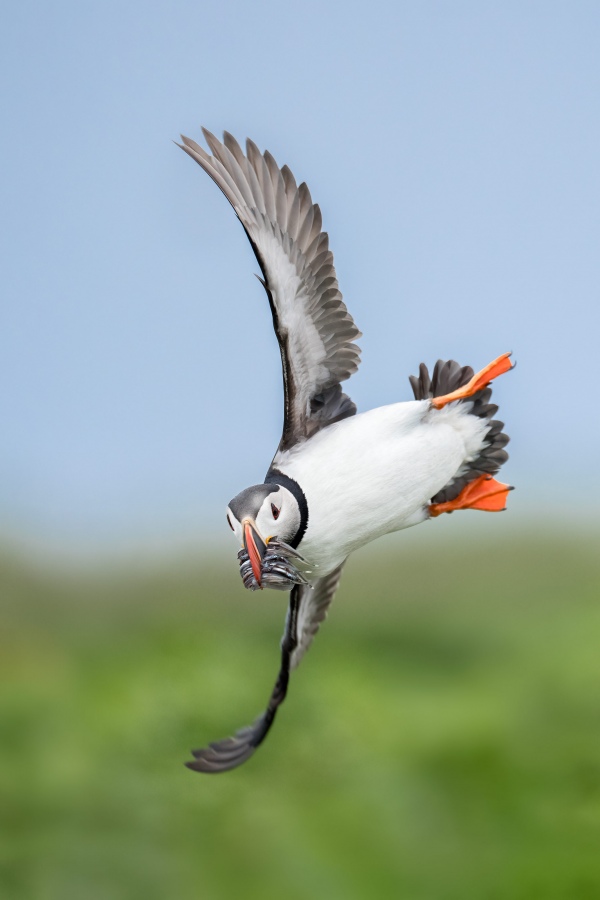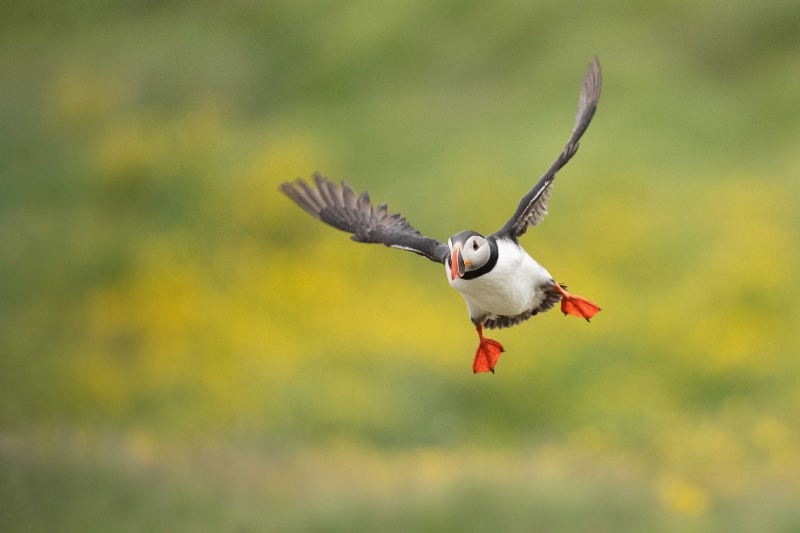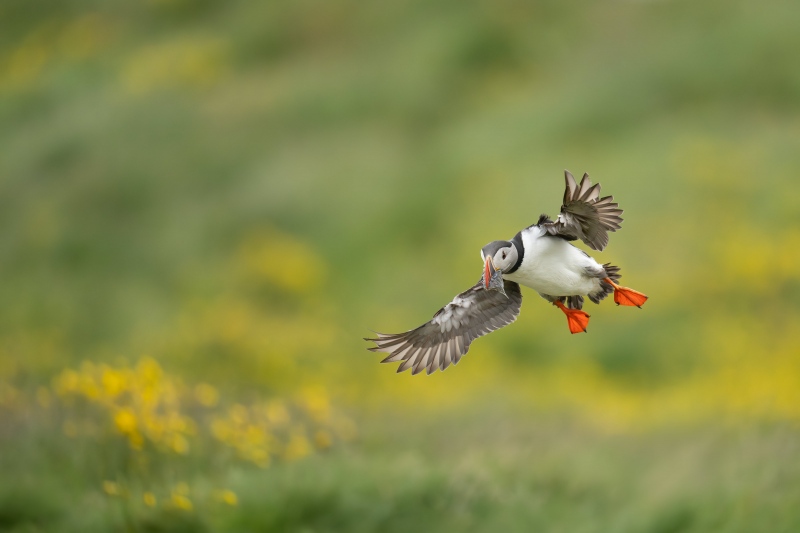What’s Up?
Grimsey continues to be fabulous. The rain is long gone and has been replaced by gloriously cloudy-bright skies that are prefect for photography. We have worked the Black Guillemots around the harbor, found a Common Ringed-Plover nest with three eggs, spent Wednesday morning photographing Northern Fulmars in flight and with chicks, and have enjoyed the best-in-the-world Atlantic Puffin photography. If anyone tells you that they will take you to the greatest-ever puffin photo location and they are not talking about Grimsey Island, they are simply not telling the truth. Grimsey is simply incredible.
On Wednesday afternoon, trip leader Greg Downing took the ferry back to the mainland with Eugen and Kevin who will be flying back to the states on Friday morning. They are all looking forward to one more chance at the Red-throated Loons. I will be photographing on Grimsey till Greg gets back with Bruce Dudek a week from today.
Today is Thursday 10 July 2023. Wherever you are and whatever you are doing, I hope that you too have a great day.
If you would like info on the 2024 and/or the 2025 puffin trips, please shoot me an e-mail by clicking here.
Please remember to use the B&H and Amazon links that are found on most blog pages and to use the BIRDSASART discount code at checkout when purchasing your new gear from Bedfords to get 3% back on your credit card and enjoy free second-day air FedEx. Please, also, consider joining a BAA IPT. You will be amazed at how much you will learn!
You can find some great photo accessories (and necessities, like surf booties!) on Amazon by clicking on the Stuff tab on the orange/yellow menu bar above. On a related note, it would be extremely helpful if blog-folks who, like me, spend too much money on Amazon, would get in the habit of clicking on the Amazon logo link on the right side of each blog post when they shop online. As you might expect, doing so will not cost you a single penny, but would be appreciated tremendously by yours truly. And doing so works seamlessly with your Amazon Prime account.
If an item — a Delkin flash card, or a tripod head — for example, that is available from B&H and/or Bedfords, is also available in the BAA Online Store, it would be great, and greatly appreciated, if you would opt to purchase from us. We will match any price. Please remember also to use my B&H affiliate links or to earn 3% cash back at Bedfords by using the BIRDSASART discount code at checkout for your major gear purchases. Doing either often earns you free guides and/or discounts. And always earns my great appreciation.
|
|
|
This image was created on 17 July 2023 at Grimsey Island, Iceland. Standing at full height on a small rise, I used the Robus RC-5558-3 Vantage Series 3 Carbon Fiber Tripod topped by the Levered-Clamp FlexShooter Pro-mounted Sony FE 600mm f/4 GM OSS lens and The One, the Sony Alpha 1 Mirrorless digital camera. ISO 3200. Exposure was determined via Zebras with ISO on the rear dial: 1/2500 sec. at f/4 (wide open). AWB at 8:07:40pm on cloudy evening. Tracking: Zone/AF-C was active at the moment of exposure and performed perfectly. Be sure to click on the image to enjoy the larger version. Image #1: Atlantic Puffin wheeling in flight with fish for chick in burrow |
Getting Ready to Shoot Flight
When you approach a flight photography situation, take a few minutes to analyze things. Ask yourself, “Where is the wind from?” Note the quality and direction of the light. Most importantly, study the patterns of the birds in flight. After you consider all the factors, choose what you think is the best gear, pick what you think is the best spot, and get to work. That is what Greg and I have done every day. Because Greg knew all the best flight spots, our job was easy; especially since we are pretty much on the same wave length.
The Third Way to Shoot Puffins in Flight
One Wednesday morning I created many sharp flight images of Northern Fulmars in flight while handling the 600mm f/4 with the 1.4X TC. As the birds came by every minute or two, handholding the 6 1/2 pound lens was do-able. With the puffins flying in non-stop, handholding was out of the question so I put the 600 f/4 GM on the tripod, and thanks to the fact that the birds were flying predictable paths and were being slowed down by the wind, I was quite successful. If you cannot hold a big lens comfortably, get it on the tripod with a /Levered-Clamp FlexShooter Pro and make some great images. Comfortably.
|
|
|
This image was also created on 17 July 2023 at Grimsey Island, Iceland. Standing at full height on a small rise, I used the Robus RC-5558-3 Vantage Series 3 Carbon Fiber Tripod topped by the Levered-Clamp FlexShooter Pro-mounted Sony FE 600mm f/4 GM OSS lens and The One, the Sony Alpha 1 Mirrorless digital camera. ISO 4000. Exposure was determined via Zebras with ISO on the rear dial: 1/2500 sec. at f/4 (wide open). AWB at 8:15:32pm on cloudy evening. Tracking: Zone/AF-C was active at the moment of exposure and performed perfectly. Be sure to click on the image to enjoy the larger version. Image #2: Atlantic Puffin incoming with suffused yellow flower background |
A Great Move
I was shooting the braking, incoming puffins against the white sky when Greg shouted over the wind, “Come on up here and you can get a sweet yellow flower background. So I walked back up the hill a bit, and did just that. I believe that the flowers are Arctic poppies.
|
|
|
This image was also created on 17 July 2023 at Grimsey Island, Iceland. Standing at full height on a small rise, I used the Robus RC-5558-3 Vantage Series 3 Carbon Fiber Tripod topped by the Levered-Clamp FlexShooter Pro-mounted Sony FE 600mm f/4 GM OSS lens and The One, the Sony Alpha 1 Mirrorless digital camera. ISO 3200. Exposure was determined via Zebras with ISO on the rear dial: 1/2500 sec. at f/4 (wide open). AWB at 8:29:27pm on cloudy evening. Tracking: Zone/AF-C was active at the moment of exposure and performed perfectly. Be sure to click on the image to enjoy the larger version. Image #3: Atlantic Puffin small in the frame with flowers |
Puffin Scapes and Flight Creativity
Autofocus with the current mirrorless gear is so good that once you have the basics down, learn to acquire focus quickly, can routinely create sharp images and keep the bird in the frame while tracking it in flight, you will often have five- or ten- or fifteen-frame sequences from which to choose the best wing positions and flight poses. The size of the bird in the frame will vary from situation to situation. As you pan with the the subject, the backgrounds will vary as well. Once you have acquired the necessary skills, the very best images are often serendipitous. The more sharp frames you can create, the greater the chance of making something special.
Your Call?
Which of today’s featured images do you like best? Why?
Typos
With all blog posts, feel free to e-mail or to leave a comment regarding any typos or errors.

















My favorite is #1. Love the wing position, the full mouth and the degree to which the puffin fills the frame. I do wish the sky line had been higher. All are beautiful. Glad you had a great trip!
Image #1 and image #2 and image #3 of Atlantic Puffin are well made and interesting and all are flighting! Also image #1 with fish for chick in burrow is funny for a chick but also well made!
Wow. I am so jealous. I have always wanted to photograph Puffins. No. 1 is absolutely my first choice. Interesting position, food in its mouth tells a story.
P.S. Small typo “Because Greg knew the all the best flight spots”. s/b knew all the best…
Tanks and fixed. No need to be jealous (or envious); sing up for next year.
a
#3 The wing position does it for me, along with the beautiful flowered background!